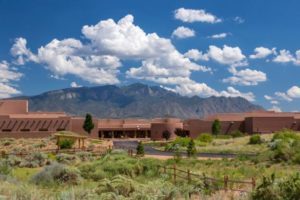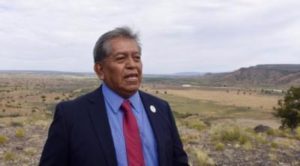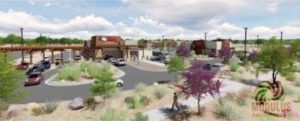
Casinos might be the bread and butter of business enterprises operated by Native American tribes and pueblos in New Mexico, but diversification is clearly on the radar as a vehicle for Indian nations to expand employment and future economic development.
To most observers, gaming establishments are the most visible and, to be sure, likely the most lucrative of many tribes’ businesses. They have added hotels to their casinos, including upscale resorts with spas, such as Sandia Resort & Casino and the Hyatt Regency Tamaya Resort and Spa, as well as recreational activities like golf and fishing, and venues for concerts.
Others have turned their economic development corporations into top government contractors and service providers, and some have active farming and ranching operations.
Creating the right mix of businesses to generate future growth has drawn the interest of companies outside Indian Country. REDW, a large certified public accounting and business consulting firm, is providing training so tribes, which represent about 40 percent of REDW’s business, can manage their own accounting, legal, financial, health and management systems.
As grateful as the tribes are for casinos, they know it’s a fickle business, subject to the health of a broader economy and with loads of competition. Savvy tribal leaders say diversification is about preparing for whatever competition heads their way so their economic future isn’t something left to chance.

Santa Ana
“You can’t rely on just one thing,” said Myron Armijo, governor of the Pueblo of Santa Ana, a 900-member tribe. “It’s never a safe bet to put all of your eggs in one basket,” he said of the first Indian casino to operate in New Mexico, which opened its doors in 1993.
But no one’s writing off the impact of the casino line of business, where one-fourth of The Star Casino workforce are Santa Ana members. “You still want to have the kind of property where people want to return to … you want to make sure your slot floor is very current,” said Armijo, who declined to reveal how much money the pueblo’s various business entities generated last year.
One recent investment was the former King Ranch, 100 square miles the pueblo acquired earlier this summer for something close to $33 million. The pueblo wants to preserve important cultural lands and has no business enterprise planned there.
But the pueblo is making casino cash work for them in other sectors. “How and when to expand? How to diversify? These are questions most tribes are asking,” he points out.
Gambling money, he said, has allowed tribes to secure the kinds of human resources and expertise that before they couldn’t afford. The casinos have provided a base and revenue to branch out. Santa Ana Pueblo’s net win for the second quarter was $21.6 million, according to the state Gaming Control Board. It was the third-ranked of the 14 New Mexico Indian-owned casinos, outdistanced only by Sandia Pueblo at $41.9 million and Isleta Pueblo at $24.3 million.

Armijo said profits from the casino, hotel, and golf courses have truly been game-changers. and the largest sources of revenue, allowing the pueblo to plow profits into developing basic infrastructure, funding a government center, schools, community centers and health care clinics, and provide seed money for members to launch businesses.
Now, the pueblo is looking to diversify further with WindRidge@Tamaya, an $8.8 million project with architecture and landscaping evocative of the pueblo on the south side of heavily traveled N.M. 550, just east of N.M. 528.
The 10-acre commercial project, which will soon break ground, is the first phase of 44 acres slated for development. It will be anchored by Central New Mexico’s first Big R store, whose products are geared toward farmers and outdoor enthusiasts. Also scheduled as tenants are a “double drive-up” Blake’s Lotaburger, and a Warrior car wash and gas station.

Target customers are visitors to the hotel and casinos, as well as locals. “We’re very much tied into the growth of Rio Rancho and Bernalillo,” said Armijo. “Five years down the road, we hope to see a thriving business district.”
The new tenants will give employment preference to tribal members, but also hire folks from local communities, as well as purchasing goods and services, said Armijo. He said future development could include call centers, a health clinic, restaurants, more retail, a bank and other users of office space.
The pueblo also owns Southern Sandoval Investments, the pueblo’s real estate and business-development arm, owns and operates Warrior Fuel gas station and smoke shop, and leases space to local businesses in its office building at 51 Jemez Canyon Dam Rd. opposite The Star Casino.
Indispensable to economic diversification is workforce development. Kevin Montoya, who was raised in the pueblo, began working on construction crews, a good training ground for his current career. He’s now the director of two tribally owned businesses: Santa Ana Golf Club Inc. and SSI. Thanks to on-the-job experience with the tribe since 2010 and classes at Central New Mexico Community College, Montoya has gained valuable experience in construction management, water and wastewater issues, utility development, financing, digital media design and marketing.

Ohkay Owingeh
Like Santa Ana, Ohkay Owingeh, formerly San Juan Pueblo, has diversified well beyond its casino and hotel. Its development company, Tsay Corp., made the decision to focus on federal contracting after gaming fell off a decade ago and this business has now grown to the point where it contributed 75 percent of the tribe’s $120 million in revenue last year, according to Ron Lovato, Tsay Corp.’s CEO.
Founded in 1994, Tsay focuses on federal contracting. It does work all over the country, including with Los Alamos National Lab, in areas such as construction and building maintenance. About 500 of its 1,200 employees are in northern New Mexico and the rest are scattered across the U.S.
“LANL gave us a shot when we had no track record,” said Lovato. “We’ve been able to leverage this business relationship nationwide.”
He said there are 3,000 enrolled members, with 2,000 living in New Mexico. In addition to the casino, the Ohkay Owingeh also own and lease several office buildings off the reservation in Rio Rancho, said Lovato.
“We’ve achieved remarkable success in facilities support services” with different federal agencies and military bases, he said of the business, which employs tribal and non-tribal members working in New Mexico, the Southeast and the Pacific Northwest. The growth in business has funded reservation home-building and remodeling, road paving, and construction of a new senior citizens center and school, said Lovato. Recently, Tsay Corp. was awarded a $7.6 million multiyear contract to provide grounds maintenance at Fort Buchanan in Puerto Rico. “Our business goals and expectations go far beyond the geography of New Mexico,” said Lovato.
Human capital
The goal of developing human capital is not lost on many of the tribes’ business partners.
Sharing its expertise with Native American tribal enterprises is REDW, which provides training that helps tribes get better at running their businesses themselves. And helping to lead the charge to self-sufficiency is one of New Mexico’s most notable sports figures – professional golfer Notah Begay.
Notah Begay, left, has teamed with accounting firm REDW to build the firm’s business in Indian Country. Begay is seen a left with REDW principals Lisa Wilcox and James Montoya.REDW, one of the Southwest’s 10 largest certified public accounting and business consulting firms, has launched a partnership with Begay as brand ambassador to Indian Country. “REDW is the national leader in providing accounting and financial reporting services to tribes and their enterprises,” said Begay, who is one-half Navajo, one-quarter San Felipe and one-quarter Isleta – and the first full-blooded Native American ever to play on the PGA Tour.
Begay, who has a degree in economics from Stanford University, said he and REDW are committed to increasing financial literacy in tribal communities in an effort to build business opportunities and financial success. “The firm’s experience positions them to serve the constantly changing priorities and requirements of tribal governments. This joint venture allows me to work harder on behalf of tribes due to REDW’s tremendous portfolio of services,” Begay said.
Chris Tyhurst, a principal and national practice leader for REDW’s tribal services division out of Phoenix, said the firm has worked for 20 years doing internal audits for tribes in casinos in areas like human resource consulting – as well as developing tribal investment software, administering trusts for minors and helping tribes run their own hospitals. “We want to empower their on-site teams to be more accomplished in these tasks and build their businesses,” Tyhurst said.
By: Steve Sinovic (Albuquerque Journal)
Click here to view source article.


